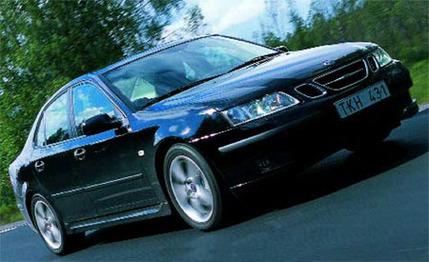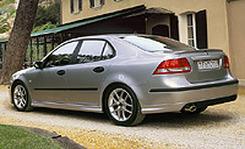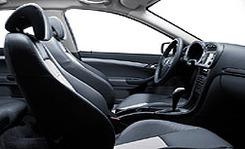
 First Drive Review
First Drive Review
One of the many things Saab Cars USA marketing V-P Hans Krondahl knows is that everyone needs a gray suit. (He also knows how to make the Swedish delicacy surströmming, in which herring is stowed in a can for six months, right up to that rotting point when it becomes ever so tasty, but that's not important right now.)
The gray-suit thing is directly applicable to the new 9-3 sedan Krondahl needs to sell. His contention is that a gray three-piece, although lacking the visual excitement of a sharkskin zoot suit, has broad appeal, is safer socially, and wouldn't scare off the most conservative shopper.
That, then, is the new Saab 9-3 sedan -- a car tailored not to offend. Krondahl can't say what color suit the current 9-3 is, but he and Saab believe it wasn't conservative enough. Company officials blame the hatchback configuration -- a Saab hallmark since the mid-'70s -- as the main culprit for less-than-thrilling sales. Current 9-3 hardtop sales in the U.S. are about 11,000 per year. That's down from the model's best year of 1986 (it was called the 900 then), when Saab sold almost 37,000. By comparison, BMW sold 61,822 3-series hardtops to U.S. customers in 1986, and last year, it sold more than 80,000 of them.


Saab contends that shoppers at the entry level of the luxury market (that includes the Audi A4, BMW 3-series, and Volvo S60) consider the hatchback the automotive equivalent of double-knit polyester. We would add that the current 9-3 is not as luxurious or sporting as those other cars, either.
Like the 9-5, which replaced the 9000 hatchback as a '99 model, the 9-3 comes only in traditional four-door, notchback garb. Saab loyalists who appreciate the uniqueness and practicality of hatches claim Saab sold out to convention. And they're right. But Saab notes the 9-5 has sales that are 70 percent better than the old 9000's. And Saab wants to more than double 9-3 hardtop sales to about 25,000 per year in the U.S.
No surprise then that the new 9-3 looks conspicuously like the wedge-shaped 9-5. It's trimmer-looking. Its bodywork appears taut. With shorter overhangs and bulging wheel arches, the 9-3 has a more tailored, more Germanic look than the overstuffed-envelope style of the current car.
Underneath the new duds is GM's Epsilon platform that the 9-3 shares with the Opel Vectra and the upcoming Chevy Malibu. Say what you will about the lack of a hatch, with this new platform the 9-3 is dramatically better in every mechanical way.
One Saab engineer compared the new car's structure to the old by saying, "It's in a whole different galaxy." That's not as much an overstatement as it sounds. Gone are most of the harsh sounds and vibrations that penetrated the current car's cabin.


The new 9-3, riding on a wheelbase nearly three inches longer (at 105.3 inches), is more comfortable and serene going down the road. Tire hum is the only outside noise to penetrate the cabin at an objectionable level. The wheelbase provides for an additional inch of rear-seat legroom compared with the current 9-3. There's more rear legroom than in other European competitors, says Saab. And the interior itself is fitted with finer, softer materials and a less-economy-car-like design.
The Epsilon platform's biggest contribution to the 9-3, though, is handling. The front-drive 9-3 is still no 3-series. But it is competent and buttoned down in a way the current car is not. Gone is the tippy feeling that makes the current 9-3 feel as if its center of gravity were a foot above the roof. The cars we drove in Sweden, with an optional sport-tuned suspension and 215/50VR-17 tires, understeered when pushed. But it was a progressive sort of push, and the car remains stable even over midcorner bumps. Helping in this regard is a new four-link independent rear suspension. The rear system incorporates passive rear steer, which slightly changes the toe of the rear tires to aid in turning. Saab also makes extensive use of aluminum to reduce unsprung weight.
The front suspension is also a great improvement. Still a strut setup, this new suspension is mounted to a stiff, hydroformed subframe with bushings that are extremely soft in longitudinal motion to improve ride quality. The same bushings are very stiff laterally, which brings a level of accuracy to the steering, not a strong point in the current car. Saab also mounted the steering rack lower in the structure to reduce some of the well-known torque steer. We had to floor the gas pedal in low gears to get even a hint of torque steer.
All the cars we sampled on this early drive had base-level 175-hp, 2.0-liter turbos. This is the only engine that will be available when this 9-3 goes on sale here in October. Then, early in 2003, a higher-boost, 210-hp version of this engine will arrive in Arc and Vector models (read "luxury" and "sport").
Both engines are versions of GM's Ecotec all-aluminum, twin-cam four-cylinder. The base-level Linear model comes with the lower-boost engine. Although 175 horsepower doesn't sound like much (it's 30 horses less than last year's base engine), it is within 10 of other European competitors' base engines and feels more than adequate for day-to-day driving. And with 195 pound-feet of torque at 2500 rpm, the Saab motor produces more torque than competitors' base engines. The high-boost engine makes 221 pound-feet of torque.
The manual transmission is a modified version of the current five-speed. But where the current unit feels uncertain and clunky, this new shifter slots decisively into its gates. Arcs and Vectors will come with a new six-speed manual. A new five-speed automatic is optional on all models. All 9-3s come standard with a full array of electronic safety systems, including ABS, traction control, and stability control.
A Linear with a manual transmission will cost $26,525. Most 9-3s on dealer lots this fall will have a Launch package of an upgraded stereo, a sunroof, 16-inch wheels, and an automatic, with a sticker just under $30,000.
That undercuts BMW, Volvo, and Mercedes. The base price is also cheaper than that of last year's five-door by more than $1000. This, for a car that is a quantum leap forward in refinement, comfort, and handling. It's a great deal on a gray suit. The question is this: Do you want this gray suit in a store full of other fine gray suits?